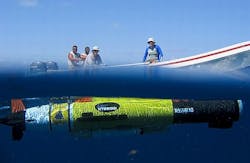Woods Hole to develop and upgrade underwater drone technologies for minehunting, ASW, and surveillance
NEWPORT, R.I., 18 Nov. 2014. Military undersea experts at the Woods Hole Oceanographic Institution in Woods Hole, Mass., develop and upgrade a variety of unmanned underwater vehicles (UUV) programs that involve underwater communications, underwater mine hunting, and anti-submarine warfare (ASW).
Officials of the Naval Undersea Warfare Center in Newport, R.I., have awarded a $35.5 million contract to Woods Hole to develop, assess, upgrade, and modernize underwater drones and other unmanned undersea technologies the Navy uses for undersea surveillance and undersea warfare.
The contract calls for Woods Hole undersea experts to work on the Navy's Persistent Littoral Undersea Surveillance (PLUS) program; the digital Acoustic Communications (Acoms) program; the Remote Environmental Measuring Units (REMUS) UUV, a fast-tracked explosive ordnance disposal program; REMUS launch and recovery systems; and related advanced ocean technologies.
Related: Teledyne Technologies becoming major player in unmanned underwater vehicle (UUV) sensors
Woods Hole experts will work on technologies involving undersea battery and energy, navigation, control, sensors, acoustic communications, data acquisition, and related shipboard systems.
The Persistent Littoral Undersea Surveillance system is designed to detect underwater threats like modern ultra-quiet diesel submarines. The system consists of an undersea network of five sea gliders and six REMUS 600 UUVs that act as deep-sea sensors. The sea gliders dive underwater to collect the Remus' data, then return to the surface to transmit that data to a shore-based collection and processing station.
Digital acoustic communications (Acoms) seeks to increase the range and data rates of underwater communications and networking with manned and unmanned submarines by finding ways to increase data rates in less-than-optimal conditions.
Acomms provide strategic communications at ranges as far as 20 nautical miles, and support future Navy capabilities for communications and networking between submarines, UUVs, surface ships, and test ranges for minehunting and mine countermeasures, tactical communications, advanced weapon systems, and undersea networking.
The REMUS UUV are robotic submarines resembling torpedoes that navigate without a human crew onboard and without cables connecting them to research vessels at the sea surface. Computers on the vehicle are used for system control, such as navigation and propulsion, as well as for data collection.
The vehicles are designed for mine hunting, coastal monitoring, and survey operations at various depths in the ocean. The REMUS vehicles can produce detailed sonar maps of the likely locations of mines hidden in harbors and coastal waterways.
Related: Unmanned underwater vehicle (UUV) research pulls into the fast lane, led by ONR contracts
On this contract Woods Hole will do the work in Woods Hole, Mass; Newport, R.I.; Andros Island, Bahamas; Groton, Conn.; Kings Bay, Ga.; Bangor, Wash.; San Diego; Pearl Harbor, Hawaii; Norfolk, Va.; Niantic, Conn.; Dresden, N.Y.; and Keyport, Wash., and should be finished by August 2019.
For more information contact the Woods Hole Oceanographic Institution online at www.whoi.edu, or the Naval Undersea Warfare Center at www.navsea.navy.mil/nuwc.

